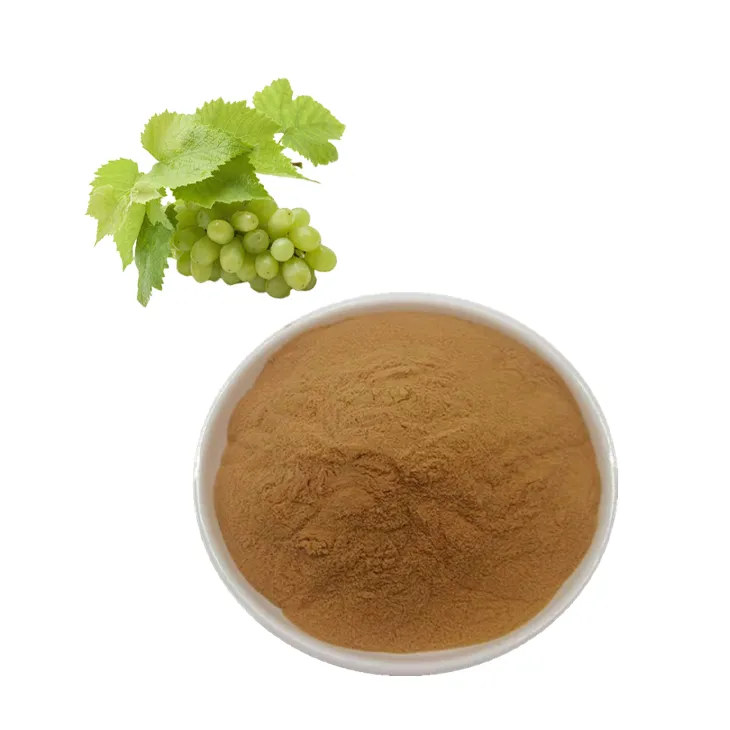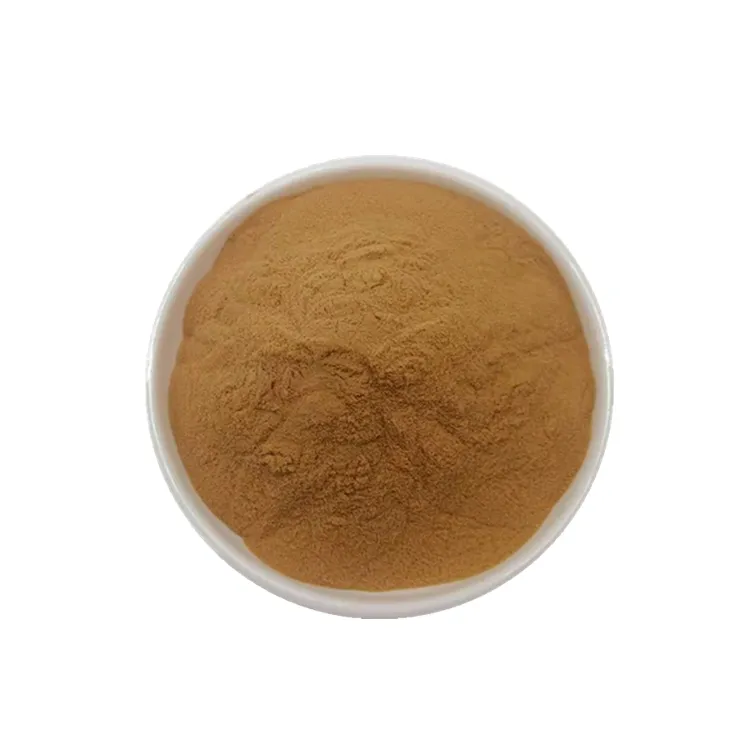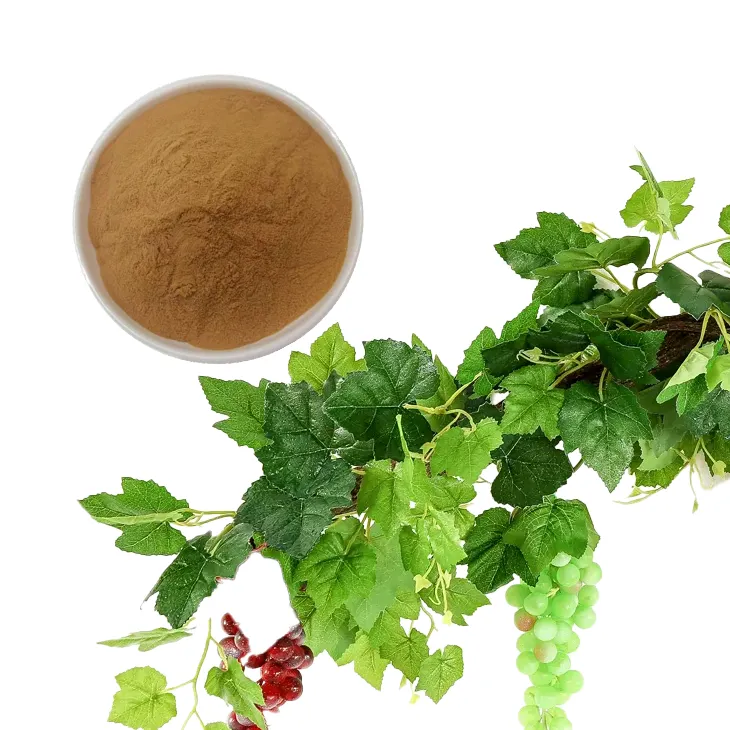- 0086-571-85302990
- sales@greenskybio.com
Organic Supercritical CO2 Extraction of Grape Leaf Extracts
2024-11-28

1. Introduction
Grape leaves, which are an often - overlooked part of the grapevine, are in fact a rich source of various bioactive compounds. The traditional extraction methods may have some limitations in terms of efficiency, selectivity, and environmental friendliness. However, the organic supercritical CO2 extraction technique has emerged as a highly advanced and environmentally - friendly method for obtaining Grape Leaf Extracts.

2. Grape Leaves: A Hidden Treasure of Bioactive Compounds
Grape leaves contain a wide range of bioactive substances. Flavonoids, for example, are one of the major groups of compounds present in grape leaves. These flavonoids have antioxidant properties that can help in protecting cells from oxidative damage. Another important group of compounds are phenolic acids. They play roles in various biological processes such as anti - inflammatory responses. Terpenoids are also found in grape leaves, and they may contribute to the unique aroma and flavor profiles of the extracts.

3. The Principle of Supercritical CO2 Extraction
Supercritical CO2 extraction is based on the unique properties of carbon dioxide in its supercritical state. When carbon dioxide is above its critical temperature and pressure (Tc = 31.1 °C, Pc = 73.8 bar), it exhibits properties that are intermediate between a gas and a liquid. In this state, CO2 has a high diffusivity like a gas and a high solvating power like a liquid.
The extraction process involves pressurizing CO2 to its supercritical state and then passing it through the grape leaves. The bioactive compounds in the grape leaves are soluble in supercritical CO2, and thus can be extracted. By adjusting the pressure and temperature conditions, the selectivity of the extraction can be controlled. For example, different bioactive compounds may have different solubilities in supercritical CO2 at different pressure - temperature combinations.

4. Advantages of Supercritical CO2 Extraction
4.1 Mild Operating Conditions
One of the major advantages of supercritical CO2 extraction is the mild operating conditions. Compared to some traditional extraction methods such as solvent extraction using organic solvents like hexane, supercritical CO2 extraction does not require high - temperature heating or the use of harsh chemicals. This helps to preserve the integrity of the bioactive components in grape leaves. Since many bioactive compounds are sensitive to heat and chemical reactions, the mild conditions of supercritical CO2 extraction are highly beneficial.
4.2 High Selectivity
The selectivity of supercritical CO2 extraction is another important advantage. As mentioned earlier, by adjusting the pressure and temperature, it is possible to selectively extract specific bioactive compounds from grape leaves. This is very useful in the isolation of valuable compounds such as flavonoids or phenolic acids. For example, if a particular flavonoid has a higher solubility in supercritical CO2 at a certain pressure - temperature combination compared to other compounds, it can be preferentially extracted.
4.3 Pure and High - Quality Extract
Supercritical CO2 extraction can produce a pure and high - quality extract. Since CO2 is a clean solvent that can be easily removed from the extract after the extraction process, there is no residue of harmful solvents in the final product. This is especially important for applications in the fields of medicine, cosmetics, and food, where the purity of the extract is crucial.
5. Potential Applications of Grape Leaf Extracts
5.1 In Medicine
The bioactive compounds in Grape Leaf Extracts may have potential applications in medicine. For example, the antioxidant properties of flavonoids can be utilized in the development of drugs for treating diseases related to oxidative stress, such as certain cardiovascular diseases. Phenolic acids may have anti - inflammatory effects, which could be beneficial for the treatment of inflammatory diseases. Additionally, some terpenoids may have antimicrobial properties, which could be explored for the development of new antibiotics.
5.2 In Cosmetics
Grape leaf extracts can also be used in the cosmetics industry. The antioxidant and anti - inflammatory properties of the bioactive compounds make them suitable for use in skin care products. For example, they can be added to creams and lotions to help protect the skin from environmental damage and reduce inflammation. Moreover, the unique aroma of terpenoids in grape leaf extracts can be used to create natural - smelling cosmetics products.
5.3 In Food
In the food industry, grape leaf extracts can be used as natural additives. The antioxidant properties can help to preserve the freshness of food products by preventing lipid oxidation. They can also be used to enhance the flavor and aroma of certain foods. For example, in the production of grape - flavored products, grape leaf extracts can add a more complex and natural flavor profile.
6. The Extraction Process in Detail
6.1 Preparation of Grape Leaves
The first step in the supercritical CO2 extraction of grape leaf extracts is the preparation of grape leaves. The grape leaves need to be collected at the appropriate time. Usually, young and healthy grape leaves are preferred as they may contain higher levels of bioactive compounds. After collection, the grape leaves are washed thoroughly to remove any dirt, pesticides, or other contaminants. Then, they are dried to a suitable moisture content. This drying process should be carried out under mild conditions to avoid the degradation of bioactive compounds.
6.2 The Extraction Setup
The extraction setup for supercritical CO2 extraction typically consists of a CO2 source, a pump to pressurize the CO2, a extraction vessel where the grape leaves are placed, and a separator to separate the extract from the CO2. The extraction vessel is designed to withstand high pressures and is usually made of stainless steel. The CO2 source provides the carbon dioxide gas, which is then pressurized by the pump to its supercritical state.
6.3 The Extraction Procedure
Once the extraction setup is ready, the dried grape leaves are placed in the extraction vessel. The supercritical CO2 is then passed through the extraction vessel at a controlled flow rate. The pressure and temperature conditions are set according to the desired selectivity of the extraction. For example, if a higher extraction of flavonoids is desired, a specific pressure - temperature combination that favors the solubility of flavonoids in supercritical CO2 is selected. The extraction process usually takes a certain amount of time, during which the bioactive compounds in the grape leaves are gradually dissolved in the supercritical CO2.
6.4 Separation and Collection of the Extract
After the extraction process, the supercritical CO2 containing the dissolved bioactive compounds is passed into the separator. In the separator, the pressure is reduced, which causes the solubility of the bioactive compounds in CO2 to decrease. As a result, the bioactive compounds are separated from the CO2 and collected. The CO2 can be recycled back to the CO2 source for further use.
7. Comparison with Other Extraction Methods
7.1 Solvent Extraction
Solvent extraction is a traditional method for extracting bioactive compounds from plant materials. However, this method has some drawbacks compared to supercritical CO2 extraction. For example, solvent extraction often requires the use of organic solvents such as hexane, ethanol, or methanol. These solvents may be toxic and leave residues in the final extract, which is not suitable for applications in medicine, cosmetics, and food. Moreover, solvent extraction may not have the same level of selectivity as supercritical CO2 extraction.
7.2 Steam Distillation
Steam distillation is another method that can be used for extracting volatile compounds from plant materials. However, this method is mainly suitable for extracting volatile terpenoids and may not be effective for extracting non - volatile bioactive compounds such as phenolic acids and some flavonoids. In addition, steam distillation may cause the degradation of some heat - sensitive bioactive compounds due to the high - temperature steam used.
8. Challenges and Future Directions
8.1 Cost - effectiveness
One of the challenges in the commercial application of supercritical CO2 extraction is its cost - effectiveness. The equipment for supercritical CO2 extraction is relatively expensive, and the operation also requires a certain amount of energy. To make this method more cost - effective, further research is needed to optimize the extraction process, reduce energy consumption, and develop more efficient extraction equipment.
8.2 Scale - up
Another challenge is the scale - up of the extraction process. Although supercritical CO2 extraction has been successfully demonstrated at the laboratory scale, there are still difficulties in scaling up the process to industrial levels. Issues such as ensuring uniform extraction conditions in large - scale extraction vessels and dealing with larger volumes of CO2 need to be addressed.
8.3 Exploration of New Bioactive Compounds
In the future, more research should be focused on exploring new bioactive compounds in grape leaves. With the development of more advanced analytical techniques, it is possible to discover new bioactive compounds that may have unique biological activities and potential applications.
9. Conclusion
In conclusion, the organic supercritical CO2 extraction of grape leaf extracts is a promising technique. It offers several advantages such as mild operating conditions, high selectivity, and the ability to obtain a pure and high - quality extract. Grape leaf extracts obtained by this method have potential applications in the fields of medicine, cosmetics, and food. However, there are also some challenges that need to be addressed, such as cost - effectiveness and scale - up. With further research and development, this extraction method is expected to play an increasingly important role in the utilization of grape leaf resources.
FAQ:
What are the main bioactive compounds in grape leaves?
Grape leaves are rich in flavonoids, phenolic acids, and terpenoids, among other bioactive compounds.
What are the advantages of supercritical CO2 extraction?
The advantages of supercritical CO2 extraction include mild operating conditions, high selectivity, and the ability to obtain a pure and high - quality extract. It can also preserve the integrity of bioactive components.
Why are grape leaves often overlooked?
Grape leaves are often overlooked perhaps because the focus has been more on the grapes themselves for winemaking or as a fruit. However, they also contain valuable substances worthy of extraction.
What are the potential applications of grape leaf extracts?
Grape leaf extracts may have potential applications in the fields of medicine, cosmetics, and food due to the presence of bioactive compounds.
How does supercritical CO2 extraction preserve the integrity of bioactive components?
Supercritical CO2 extraction uses mild operating conditions which are less likely to damage or degrade the bioactive components in grape leaves, thus preserving their integrity.
Related literature
- Supercritical Fluid Extraction of Bioactive Compounds from Grape Leaves: A Review"
- "The Use of Supercritical CO2 in Extracting Valuable Substances from Grape Leaves"
- "Advances in Organic Supercritical CO2 Extraction of Grape Leaf - Derived Bioactive Compounds"
- ▶ Hesperidin
- ▶ Citrus Bioflavonoids
- ▶ Plant Extract
- ▶ lycopene
- ▶ Diosmin
- ▶ Grape seed extract
- ▶ Sea buckthorn Juice Powder
- ▶ Fruit Juice Powder
- ▶ Hops Extract
- ▶ Artichoke Extract
- ▶ Mushroom extract
- ▶ Astaxanthin
- ▶ Green Tea Extract
- ▶ Curcumin
- ▶ Horse Chestnut Extract
- ▶ Other Product
- ▶ Boswellia Serrata Extract
- ▶ Resveratrol
- ▶ Marigold Extract
- ▶ Grape Leaf Extract
- ▶ New Product
- ▶ Aminolevulinic acid
- ▶ Cranberry Extract
- ▶ Red Yeast Rice
- ▶ Red Wine Extract
-
Cassia Seed Extract
2024-11-28
-
Propolis Extract Powder
2024-11-28
-
Peppermint Extract Powder
2024-11-28
-
Andrographis Paniculata Extract Powder
2024-11-28
-
Purple Sweet Potato Extract
2024-11-28
-
White mustard seed extract
2024-11-28
-
Beta Carotene
2024-11-28
-
Bayberry Extract
2024-11-28
-
Bilberry Extract
2024-11-28
-
Camu Camu Extract
2024-11-28





















